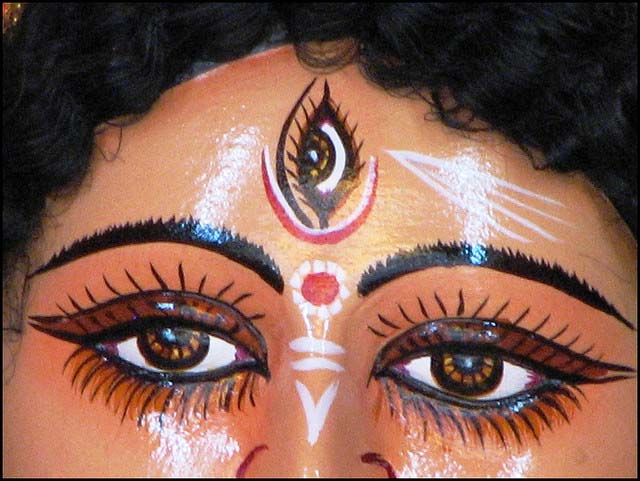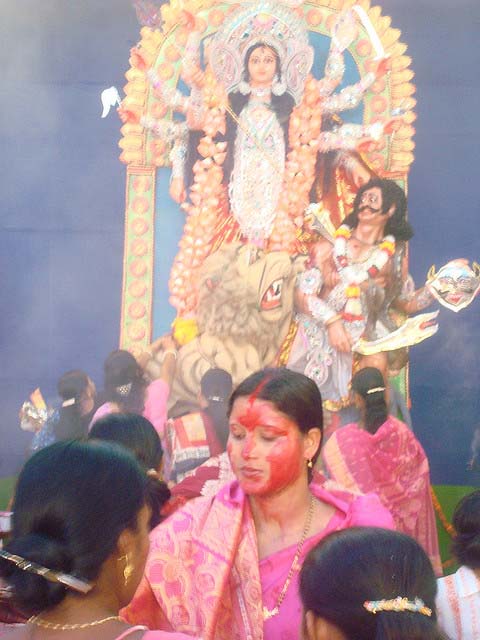Divine Eyes of Durga Photo: Amal Biswas
Gods of the Hindu Pantheon
Ever wondered why Hindu gods and goddesses have multiple heads, limbs and eyes?
Word as a vehicle of expression of thought is a powerful instrument – but its adequacy is limited to the phenomenal world. That is why an individual’s personal spiritual realization is inexpressible in its totality.
Mythology is an offshoot of this inefficacy of word while dealing with celestial events. The saintly scholar in this arena is seized with the problem of adequately narrating a superhuman extraordinary event, and tends to exaggerate. He needs to respond to his inner clamor to bestow the highest glory to the Lord with love, respect and adoration.
This has inevitably resulted in the Hindu pantheon having gods and goddesses with multiple heads and hands, but then so do cosmic evil forces too. There is a deep philosophical significance in this.
Take, for example, Devi Durga. This is how it goes:
The Power of Devi, Durga, Kali Ma
Brahma, Vishnu and Shiva, overseeing extension (creation) of the universe, its preservation and its dissolution for the purpose of recreation, remain ever busy with their respective responsibilities. What warranted a joint conference was the havoc wrought by Mahishasura, the buffalo demon, in heaven after chasing out and rendering the gods homeless.
Lesser gods were reduced to living in pitiable condition. They were no match for the demon who could change into any animal or human form; whose every drop of blood oozing out of injuries gave birth to other demons. None lived in peace on earth, heaven and the netherworld. Mahishasura was additionally equipped with an earlier celestial boon that protected him from being destroyed by any male warrior.
The tales of horror and bigotry so enraged the Holy Trimurti (Trinity) that flames of anger emanated from their mouth. The flames mingled with combined inner strength of all gods, and out of the fire there emerged a fully grown goddess who introduced herself as Devi Durga, the would-be slayer of the buffalo demon. It had to be a goddess warrior, as no male form could defeat Mahishasura.
Devotees worshiping Goddess Durga, also known as Kali Ma. Photo: Rajkumar1200
The multi-armed Devi Durga – variously depicted as having eight or ten or twelve or eighteen or twenty hands – holding several objects and wielding myriad of celestial weapons fought the epic cosmic battle with Mahishasura, and emerged as Mahishasuramardini, the slayer of the demon.
Multiple hands or heads are designed to provide the celestial beings with superhuman strength and multi-tasking ability. Whether the artisan should pour out his heart in equipping the Devi with eight or eighteen hands, may trigger off a debate among the scriptural scholars. But the point of interest is the multiplicity of the limb. And philosophy does have a justification here.
The Power of Mahishasura – Ego, Selfishness, Prejudice, Jealousy and Greed
Mahishasura is the demonic embodiment of excessive ego, selfishness, prejudice, jealousy and greed. Every drop of his blood gives birth to other demons. Philosophically, each of the attitudes that constitute the demonic embodiment gives birth to more and more ego, selfishness, prejudice, jealousy and greed in a never ending vortex of life and living.
Mahishasura is a cosmic evil. We face such evils in our everyday existence too. According to Bansi Pandit, ‘It conveys the idea that one weapon cannot destroy all the different kinds of enemies. Different weapons must be used to fight enemies depending upon the circumstances. For example, selfishness must be destroyed by detachment, jealousy by eschewal, prejudice by self-knowledge, and ego by discrimination.’
Devi Durga is also depicted astride a lion or a tiger. The Devi is fierce while dealing with evil. This fierceness is matched by the innate nature of her carrier. The celestial beings of the Hindu pantheon are mostly endowed with animals or birds as carriers that are commensurate with the qualities required for discharging their assigned divine responsibilities. Philosophically, it aims at inculcating a spirit of respect towards the animal world by humans underlining the scriptural dictum that all are manifestations of the one absolute reality – the Brahman.
Another point of interest is why should an evil being like Mahishasura be given a celestial boon? He had earlier practiced severe penance and meditation to please Brahma who conceded to the request for the demon’s invincibility against any man and god.
It at once emphasizes the point that even the gods are bound by cosmic laws and that a boon once granted cannot be withdrawn. Even in this phenomenal world, words once spoken leave as permanent a mark. It envisages that penance and meditation by a devotee, even one who could turn evil with the power thus gained, is always fruitful. If he turns evil, the law of Karma will invariably catch up with him…

Tapas Mukherjee was a journalist in India for over 40 years. He has written on many topics for several publications, but was a business journalist in the latter part of his career with the ABP group of publications. Since his retirement, he has immersed himself with research on spirituality, and the journey of the soul.
Related Articles:
Karma 101
Finding God – One Man’s Search
What are your favorite tales from Hindu mythology and what do you think they tell us about Man and God?



10 Comments
@ Pratibha – Thank you for commenting. I am so glad that it has served some purpose for some people.
I had often wondered about the extra limbs and heads as a child. It always fascinated me. As a grown up, too many things took precedence over my curiosity.Thank you for such an informative post.
@ Jim – I am glad it helped to understand.
Really interesting.. I, like others not of your faith, wondered about it. Thank You
Tapas – thank you! I think you are becoming our go to guide on all the questions we’ve ever had about spirituality! You do explain it so clearly and we look forward to more such posts.
@ Anna – I am very happy that the post served to clarify your inquiry. Thank you for commenting.
@ Swati – Glad it was of use to you. Thank you for commenting.
@ Kriti – You are right, the art work is really beautiful. Lavina deserves all the thanks she is receiving.
@ Lavina – Thanks for everything.
Anna, thanks for your comment. I think all of us wonder about these multiple limbs but there is such a beautiful explanation for it all.I’m sure Tapas Mukherjee will also respond to your comment.
Thank you Lavina for posting this. I love the comparison of the weapons in each hand with our daily lives. How we need to change our strategy to combat each situation. Loved the picture of Ma Durga with it too. It is fabulous.
That explained so many things….enjoyed reading it very much. Thank you Lavina….
I have wondered, actually. This is very interesting.